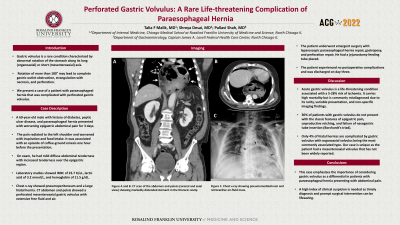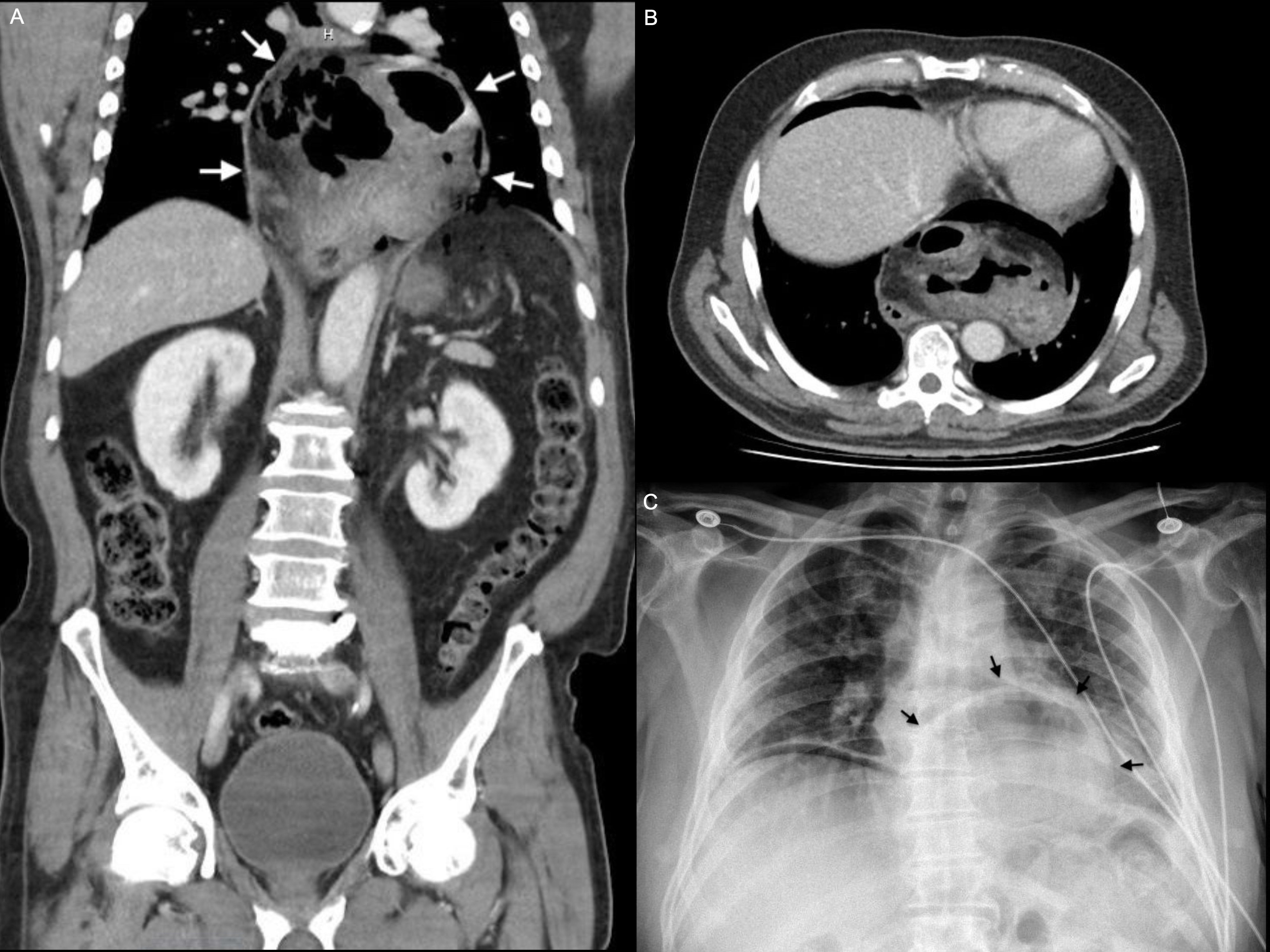Back


Poster Session C - Monday Afternoon
Category: Stomach
C0703 - Perforated Gastric Volvulus: A Rare Life-Threatening Complication of Paraesophageal Hernia
Monday, October 24, 2022
3:00 PM – 5:00 PM ET
Location: Crown Ballroom

Has Audio

Talia F. Malik, MD
Chicago Medical School at Rosalind Franklin University of Medicine and Science
North Chicago, IL
Presenting Author(s)
Talia F. Malik, MD1, Shreya Desai, MD1, Pallavi Shah, MD2
1Chicago Medical School at Rosalind Franklin University of Medicine and Science, North Chicago, IL; 2Captain James A. Lovell Federal Health Care Center, North Chicago, IL
Introduction: Gastric volvulus is a rare condition characterized by abnormal rotation of the stomach along its long (organoaxial) or short (mesenteroaxial) axis. Rotation of more than 180° may lead to complete gastric outlet obstruction, strangulation with necrosis, and perforation. We present a case of a patient with paraesophageal hernia that was complicated with perforated gastric volvulus.
Case Description/Methods: A 69-year-old male with history of diabetes, peptic ulcer disease, and paraesophageal hernia presented with worsening epigastric abdominal pain for 3 days. The pain radiated to the left shoulder and worsened with inspiration and food intake. It was associated with an episode of coffee-ground emesis one hour before the presentation. He reported similar symptoms a year ago when he was diagnosed with peptic ulcer disease. On exam, the vitals were stable. He had mild diffuse abdominal tenderness with increased tenderness over the epigastric region. Electrocardiogram was normal. Laboratory studies showed WBC of 23.7 K/uL, lactic acid of 3.2 mmol/L, and hemoglobin of 11.5 g/dL. Liver function tests and lipase were normal. Chest x-ray showed pneumoperitoneum and a large hiatal hernia. CT abdomen and pelvis showed a perforated mesenteroaxial gastric volvulus with extensive free fluid and air. The patient underwent emergent surgery with laparoscopic paraesophageal hernia repair, gastropexy, and perforation repair. He had a jejunostomy feeding tube placed. The patient experienced no postoperative complications and was discharged on day three.
Discussion: Acute gastric volvulus is a life-threatening condition associated with a 5-28% risk of ischemia. It carries high mortality but is commonly misdiagnosed due to its rarity, variable presentation, and non-specific imaging findings. 30% of patients with gastric volvulus do not present with the classic features of epigastric pain, unproductive retching, and failure of nasogastric tube insertion (Borchardt’s triad). Only 4% of hiatal hernias are complicated by gastric volvulus with organoaxial volvulus being the most commonly associated type. Our case is unique as the patient had a mesenteroaxial volvulus that has not been widely reported. This case emphasizes the importance of considering gastric volvulus as a differential in patients with paraesophageal hernia presenting with abdominal pain. A high index of clinical suspicion is needed as timely diagnosis and prompt surgical intervention can be lifesaving.

Disclosures:
Talia F. Malik, MD1, Shreya Desai, MD1, Pallavi Shah, MD2. C0703 - Perforated Gastric Volvulus: A Rare Life-Threatening Complication of Paraesophageal Hernia, ACG 2022 Annual Scientific Meeting Abstracts. Charlotte, NC: American College of Gastroenterology.
1Chicago Medical School at Rosalind Franklin University of Medicine and Science, North Chicago, IL; 2Captain James A. Lovell Federal Health Care Center, North Chicago, IL
Introduction: Gastric volvulus is a rare condition characterized by abnormal rotation of the stomach along its long (organoaxial) or short (mesenteroaxial) axis. Rotation of more than 180° may lead to complete gastric outlet obstruction, strangulation with necrosis, and perforation. We present a case of a patient with paraesophageal hernia that was complicated with perforated gastric volvulus.
Case Description/Methods: A 69-year-old male with history of diabetes, peptic ulcer disease, and paraesophageal hernia presented with worsening epigastric abdominal pain for 3 days. The pain radiated to the left shoulder and worsened with inspiration and food intake. It was associated with an episode of coffee-ground emesis one hour before the presentation. He reported similar symptoms a year ago when he was diagnosed with peptic ulcer disease. On exam, the vitals were stable. He had mild diffuse abdominal tenderness with increased tenderness over the epigastric region. Electrocardiogram was normal. Laboratory studies showed WBC of 23.7 K/uL, lactic acid of 3.2 mmol/L, and hemoglobin of 11.5 g/dL. Liver function tests and lipase were normal. Chest x-ray showed pneumoperitoneum and a large hiatal hernia. CT abdomen and pelvis showed a perforated mesenteroaxial gastric volvulus with extensive free fluid and air. The patient underwent emergent surgery with laparoscopic paraesophageal hernia repair, gastropexy, and perforation repair. He had a jejunostomy feeding tube placed. The patient experienced no postoperative complications and was discharged on day three.
Discussion: Acute gastric volvulus is a life-threatening condition associated with a 5-28% risk of ischemia. It carries high mortality but is commonly misdiagnosed due to its rarity, variable presentation, and non-specific imaging findings. 30% of patients with gastric volvulus do not present with the classic features of epigastric pain, unproductive retching, and failure of nasogastric tube insertion (Borchardt’s triad). Only 4% of hiatal hernias are complicated by gastric volvulus with organoaxial volvulus being the most commonly associated type. Our case is unique as the patient had a mesenteroaxial volvulus that has not been widely reported. This case emphasizes the importance of considering gastric volvulus as a differential in patients with paraesophageal hernia presenting with abdominal pain. A high index of clinical suspicion is needed as timely diagnosis and prompt surgical intervention can be lifesaving.

Figure: Figure 1. (A and B) CT scan of the abdomen and pelvis (coronal and axial view) showing a markedly distended abdomen in the thoracic cavity. (C) Chest x-ray showing pneumoperitoneum and retrocardiac air-fluid mass.
Disclosures:
Talia Malik indicated no relevant financial relationships.
Shreya Desai indicated no relevant financial relationships.
Pallavi Shah indicated no relevant financial relationships.
Talia F. Malik, MD1, Shreya Desai, MD1, Pallavi Shah, MD2. C0703 - Perforated Gastric Volvulus: A Rare Life-Threatening Complication of Paraesophageal Hernia, ACG 2022 Annual Scientific Meeting Abstracts. Charlotte, NC: American College of Gastroenterology.
